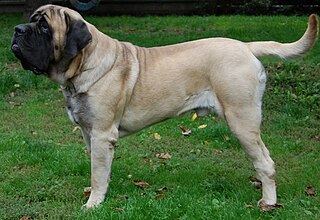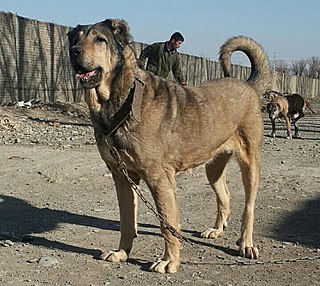
The St. Bernard or St Bernard is a breed of very large working dog from the western Alps in Italy and Switzerland. They were originally bred for rescue work by the hospice of the Great St Bernard Pass on the Italian-Swiss border. The hospice, built by and named after Italian monk Bernard of Menthon, acquired its first dogs between 1660 and 1670. The breed has become famous through tales of Alpine rescues, as well as for its large size.

A mastiff is a large and powerful type of dog. Mastiffs are among the largest dogs, and typically have a short coat, a long low-set tail and large feet; the skull is large and bulky, the muzzle broad and short (brachycephalic), and the ears drooping and pendant-shaped. European and Asian records dating back 3,000 years show dogs of the mastiff type. Mastiffs have historically been guard dogs, protecting homes and property, although throughout history they have been used as hunting dogs, war dogs and for blood sports, fighting each other and such animals as bulls, bears and lions.

The Tibetan mastiff is a large Tibetan dog breed belonging to the mastiff family. Its double coat is long, subject to climate, and found in a wide variety of colors, including solid black, black and tan, various shades of red and bluish-gray, often with white and blue markings.

The Kangal Shepherd Dog is a breed of large livestock guardian dog in Sivas, Turkey. Originally the breed served people of Anatolia, where the Kangal continues to be a popular dog breed in Turkey. This dog is classified as the Anatolian Shepherd Dog by some canine registries. The Kangal has a more curly tail and its eyes look pulled back. The breed is of an early Mastiff type with a solid pale tan or sabled coat, and a black mask. According to official Kangal Shepherd Dog organisations in Turkey, including the Cynology Federation of Turkey and the Ankara Kangal Association, Kangals may also be brindle or feature a recessive black tan pattern; with or without a black mask; and/or with white markings.

A guard dog or watchdog is a dog used to guard property against, and watch for, unwanted or unexpected human or animal intruders.

The English Mastiff is a breed of large dog. The breed is referred to simply as the Mastiff by national kennel clubs, including the United Kingdom's Kennel Club and the Fédération Cynologique Internationale. They perhaps descended from the ancient Alaunt and Pugnaces Britanniae, with a significant input from the Alpine Mastiff in the 19th century. Distinguished by its enormous size, massive head, short coat in a limited range of colours, and always displaying a black mask, the Mastiff is noted for its gentle and loving nature. The lineage of modern dogs can be traced back to the early 19th century, but the modern type was stabilised in the 1880s and refined since. Following a period of sharp decline, the Mastiff has increased its worldwide popularity. Throughout its history the Mastiff has contributed to the development of a number of dog breeds, some generally known as mastiff-type dogs, or, confusingly, just as "mastiffs".

The Bully Kutta or Indian Mastiff is a type of large dog that originated in the Indian subcontinent, dating back to the 16th century. The Bully Kutta is a working dog used for hunting and guarding. The type is popular in the Punjab region of India and Pakistan, including Haryana and Delhi, as well as in Tamil Nadu.

The Molossus was a breed of dog from Ancient Greece.

The Rafeiro do Alentejo is a Portuguese breed of livestock guardian dog. It is named for its area of origin, the Alentejo region of southern Portugal. It is recognised by the Clube Português de Canicultura, and was definitively accepted by the Fédération Cynologique Internationale in 1954.
Kuthi Valley is a Himalayan valley situated in the Pithoragarh District, Kumaon division of the Uttarakhand state of India. Located in the eastern part of Uttarakhand, it is the last valley before the border with Tibet. It runs along a NW to SE axis, formed by the river Kuthi Yankti, which is one of the headwaters of the Kali River that forms the boundary between India and Nepal in this region.

The Bakharwal dog is found in northern India. It is an ancient working Indian dog breed found across the Pir Panjal Range of India, where it has been bred for many centuries by the Bakarwal and Gujjar nomadic tribes, as a livestock guardian dog and settlement protector. While the Bakharwal Dog is mainly found in India, it is found in smaller numbers in Afghanistan and Pakistan.

The Alpine Mastiff is an extinct Molosser dog breed. Although they have the same origin as Saint Bernards, they are still two totally different breeds. Alpine Mastiff is a major contributor to the modern Mastiff, as well as to other breeds that derive from these breeds or are closely related to them. M.B. Wynn wrote, "In 1829 a vast light brindle dog of the old Alpine mastiff breed, named L'Ami, was brought from the convent of Great St. Bernard area, and exhibited in London and Liverpool as the largest dog in England." William Cavendish, 5th Duke of Devonshire, is believed to have bred Alpine Mastiffs at Chatsworth House.
Bhotiyas are people of presumed Tibetan heritage that live along the Indo-Tibetan border in the upper reaches of the Great Himalayas, at elevations ranging from 6,500 feet (2,000 m) to 13,000 feet (4,000 m). In Uttarakhand, they inhabit seven river valleys, three in the Garhwal division and four in the Kumaon division. Their main traditional occupation is Indo-Tibetan trade, with limited amounts of agriculture and pastoralism. They follow Hinduism and Buddhism and traditionally speak West Himalayish languages, which are slowly getting replaced by the predominant Indo-Aryan languages of the region.
Mountain dog is a term used in some English-language names of some breeds and regional varieties of dog, all livestock guardian types.
The Tibetan Kyi Apso is a breed of livestock guardian dog from Tibet.

The Greek Shepherd or Greek Sheepdog is a breed of livestock guardian dog from Greece. Thought to be ancient in origin, the Greek Shepherd is very closely related to livestock guardian dog breeds from neighbouring countries; it is believed that some dogs are simultaneously claimed to be other breeds as they migrate annually across national borders with the flocks they protect in search seasonal pastures.

The Cão de Gado Transmontano or Transmontano Mastiff is a breed of livestock guardian dog from Portugal. It originates in the historical province of Trás-os-Montes e Alto Douro in north-eastern Portugal, and is a rare breed confined mostly to this area.

The Sarabi dog, also known as the Bewada Dog & Iranian shepherd dog,Persian mastiff, or Iranian mastiff, is a breed of livestock guardian dog from the East Azerbaijan Province in northern Iran, taking their name from the Sarab County.
The Kars, known as the Kars Köpeği in Turkish, is a breed of livestock guardian dog from eastern Turkey.














